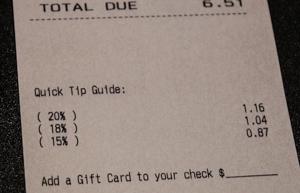A Tipping Point ...
DO YOU KNOW . . . HOW YOUR RESTAURANT SERVERS ARE COMPENSATED?

As in all states, compensation in the Commonwealth of Virginia is based on the federal minimum wage of $7.25 an hour. (When Franklin Delano Roosevelt initiated the minimum wage program in 1938, the figure was 25 cents an hour, so things have improved.) Servers, however, are paid only $2.13 an hour and rely on customers for tips to make up the difference between that and the federal minimum wage. (If on a given shift the server does not earn enough in tips to make $7.25 an hour, the restaurant must pay the difference.) Some restaurants also have a “tip pool,” in which servers are required to hand over part of their tips to help compensate other workers (for example, bussers and dishwashers).
One further proviso applies. Because credit card companies charge businesses a processing fee (usually ranging from 1.5 – 3.5%), restaurants are allowed to apply this fee to a server’s tips. This means, for example, that an 18% tip could be reduced to 15% or so in the actual wages a server takes home. There can also be a time lag associated with the use of credit cards, so while a server can take home cash tips at the end of a shift, they might not realize tips from a credit card for a few days.
So what are some of the practical consequences of these facts?
• Consider paying tips with cash if you have enough on hand to adequately compensate your server. • If you leave a tip on a credit card, consider leaving a more generous tip than if you had paid with cash. • Consider using a 15% tip as a starting point—and moving up from there for particularly warm and friendly service (which in my experience is the rule rather than the exception). • Calculate a 20% tip easily by moving the decimal point (to get 10% of your total bill) and then doubling the amount you come up with. For example, if the bill comes to $25, it’s easy to see that 10% is $2.50, so a 20% tip would be $5. On a bill of $45, a 20% tip would be $9. (Or consider carrying a “tipping chart” for easy calculation.) • If you use a coupon to reduce the cost of your meal, tip on the full cost before the discount.
A recent poll reveals that seniors (aged 72 and above), groups of women, and Southerners are among the least generous tippers, so perhaps it’s time to change that perception . . . at least among Sunnyside residents in Harrisonburg and Rockingham restaurants!
--John Noffsinger